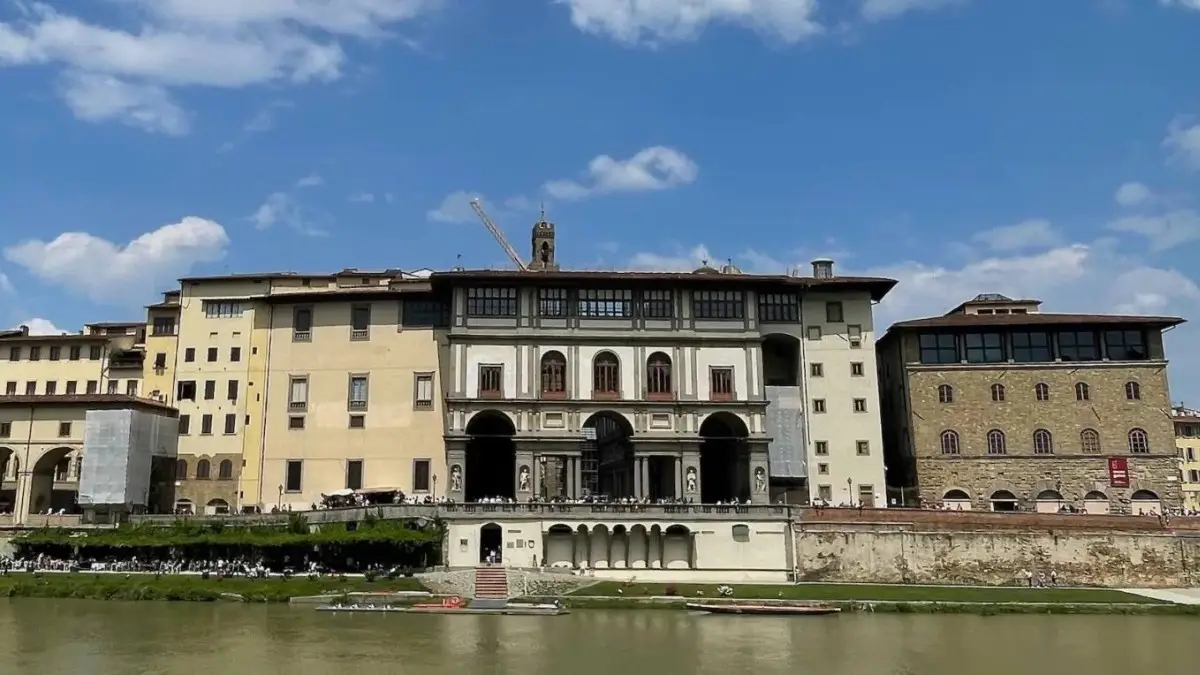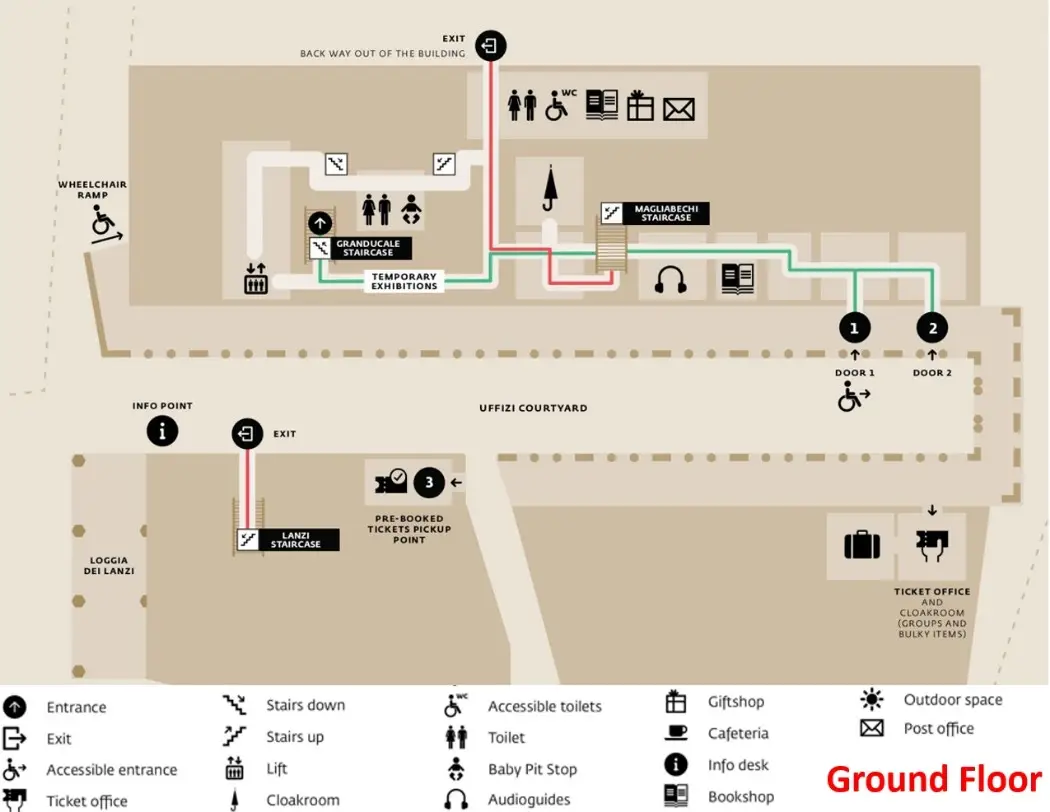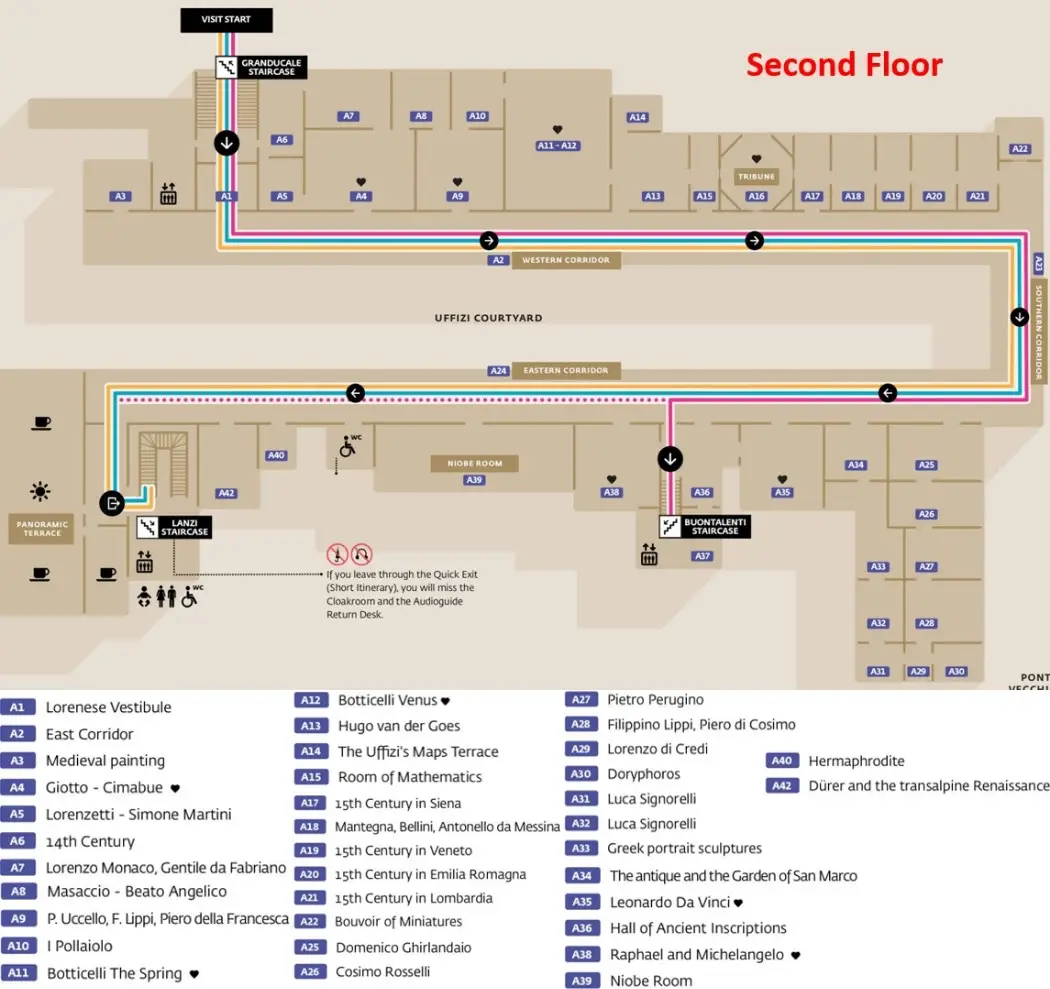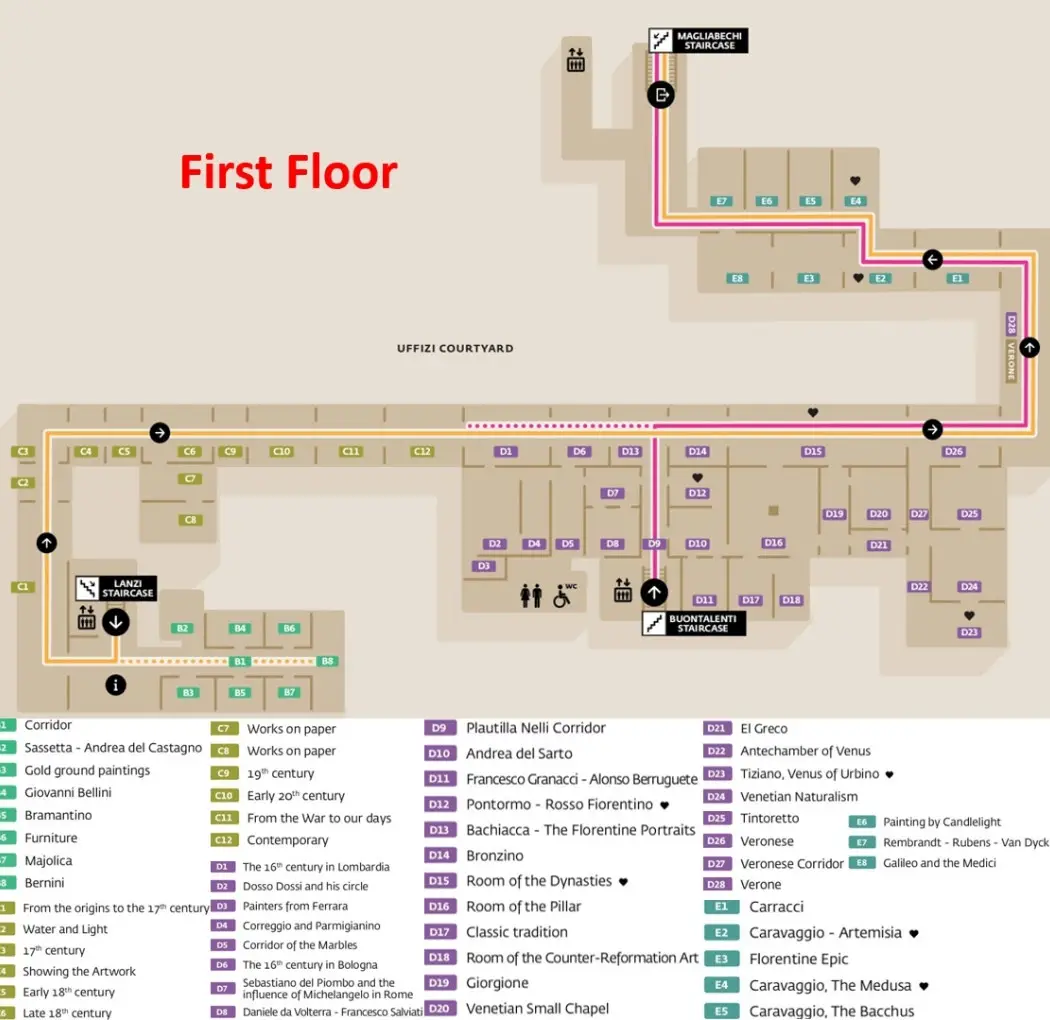Floor map of the Uffizi Gallery
Ground floor, First floor, and Second floor layouts and details

The Uffizi Gallery, a U-shaped museum spread across three floors, is considered one of the top and oldest museums in the world.
It entirely occupies the first and second floors of a large building constructed between 1560 and 1580, designed by Giorgio Vasari.
The museum houses outstanding collections of ancient sculptures and paintings, ranging from the Middle Ages to the Modern period, including masterpieces by renowned artists such as Giotto, Botticelli, Leonardo, Raphael, Michelangelo, and Caravaggio, alongside precious works by European painters.
This article will give you an overview of the Uffizi Gallery’s layout and what you can expect to find on each floor.
The Uffizi Gallery attracts over 3 million visitors annually, so booking in advance is a smart move. The Skip-the-Line ticket is the most popular and budget-friendly option. The Guided Tour ticket includes expert insights, while the Small Group Tour offers a more personal experience with fewer people.
Ground Floor: Uffizi Gallery

The ground floor of the Uffizi Gallery acts as the main entry and orientation area for visitors. While most of the gallery’s masterpieces are housed on the upper floors, the ground floor plays a key role in organizing the visitor experience.
There are two main entrances—Door 1, which is wheelchair accessible with a ramp, and Door 2, used by the general public.
Those who have pre-booked their tickets can collect them from the dedicated pickup point near the Lanzi Staircase, labeled as Point 3 on the map.
Before beginning the tour, visitors can stop by the Info Point in the Uffizi Courtyard for brochures, assistance, or general inquiries.
Near the entrance from Piazza della Signoria, the ticket office also features a cloakroom, which is ideal for storing large or bulky items, especially helpful for groups or travelers with bags.
The ground floor provides access to the Temporary Exhibitions area, which often features rotating collections and special displays worth exploring.
To reach the upper floors, visitors can use either the Granducale or Magliabechi staircases.
Additional amenities on this level include accessible restrooms, gift shops, postal services, and an audio guide rental counter.
Exits are clearly marked, with one near the Info Point and another providing a back exit route from the building. Though often overlooked, the ground floor is essential for a smooth and informed visit to the Uffizi Gallery.
Second Floor: Uffizi Gallery

We recommended that you start your visit on the second floor, which is considered the top floor by Italian standards. Access to this floor is primarily via a grand staircase dating back to the 1500s, built during the Medici era.
Small elevators/lifts are available for visitors with physical impairments, though lifts in the east wing are currently not accessible.
Must-visit halls on the second floor
The second floor contains 45 halls (or rooms) and displays works of art from the 13th to the 18th centuries. Many of the most important artworks you come to see at the Uffizi are on this floor.
- Hall 2 – Giotto & the 13th Century: This hall reflects a major shift in Italian painting at the end of the 13th century. It displays the beautiful Maestà by Giotto, Cimabue, and Duccio di Buoninsegna, highlighting Giotto’s pioneering approach to modern painting and creating a sense of physical and humanized figures.
- Halls 5/6 – International Gothic: Showcases the international or flamboyant Gothic style from the late 14th and early 15th centuries, characterized by rich clothes, graceful poses, and sophisticated shapes. Notable works include Gentile da Fabriano’s Adoration of the Magi (1423) and works by Lorenzo Monaco.
- Hall 7 – Gentile da Fabriano (Early Renaissance): Features important masterpieces from the Early Renaissance, demonstrating a shift from the Gothic style with a focus on perspective, anatomy, and light study. Key artworks include Santa Lucia dei Magnoli Altar Piece by Domenico Veneziano and Battle of San Romano by Paolo Uccello.
- Hall 8 – Filippo Lippi: Dedicated to Filippo Lippi, a key figure of the Early Renaissance and the first master of Sandro Botticelli. You can see works like the Pala del Noviziato altarpiece and Coronation of the Virgin, along with the Madonna with a Child and two angels.
- Halls 10/14 – Botticelli (The Botticelli Room): Famous for showcasing Sandro Botticelli’s greatest works, including The Birth of Venus and The Spring, which embody the essence of the Renaissance. These paintings reflect the Neo-Platonic philosophy, blending ancient Greek thought with Christianity.
- Hall 15 – Leonardo da Vinci: Displays early masterpieces by a young Leonardo da Vinci, such as the Baptism of Christ (partially by Verrocchio), Annunciation (showcasing scientific attention to nature), and the unfinished Adoration of the Magi. Works by other masters like Perugino and Luca Signorelli are also present.
- Hall 35 – Michelangelo & the Florentines: This recently opened hall (January 2013) explores the evolution of art from the High Renaissance to Mannerism. It features Michelangelo’s Tondo Doni (the only movable painting by him in Florence) and works by Andrea del Sarto, among others, as well as the Roman sculpture Sleeping Ariadne.
At the end of the second floor, above the Loggia dei Lanzi, you’ll find a cafeteria with a panoramic view of Palazzo Vecchio and Florence’s historic centre.
The three corridors that line the interior of the U-shaped building on this floor display numerous sculptures from the Medici collections.
First Floor: Uffizi Gallery

After visiting the second floor, you can continue your visit to the first floor. As part of the ongoing “New Uffizi” project to modernize the museum, some sections on this floor have been renovated, identified by their blue and red walls, displaying works by 17th and 18th-century foreign painters, 15th-century Tuscans, and Hellenistic marble sculptures.
Temporary exhibitions are often organized on this floor, and your museum ticket includes entry to these exhibitions.
Must-visit halls on the first floor:
This floor contains 56 halls (or rooms), numbered 46 to 101. It houses the “Cabinet of Prints and Drawings” within the Uffizi collection and sections dedicated to Spanish, Dutch, and French painters.
- Halls 57 and 58 – Andrea del Sarto and Raphael (The Red Rooms): These halls showcase works by influential artists like Andrea del Sarto, including his Madonna of the Harpies (1517), and feature artworks by Pontormo and Vasari.
- Hall 66 – Raffaello: This hall displays wonderful works by Raphael from his time in Florence (1504-1508), notably the Madonna of the Goldfinch (c. 1505–1506). You can observe Leonardo da Vinci’s influence on Raphael’s style, as well as Raphael’s famous self-portrait.
- Hall 83 – Titian (Tiziano): A new and beautiful hall entirely dedicated to Titian (Tiziano Vecellio), a leading figure of the Venetian school. It features ten of his works, including the famous Venus of Urbino (1538) and Flora (c. 1515–1517).
- Room 90 – Caravaggio: Dedicated to the renowned artist Caravaggio, often considered a pioneer of modern art. This room displays three of his most famous paintings: Bacchus (c. 1597), Medusa (c. 1597, painted on a shield for a 3D effect), and The Sacrifice of Isaac (1603). Adjacent rooms feature works by artists influenced by Caravaggio, such as Artemisia Gentileschi.
Additional services and amenities at the Uffizi Gallery
The Uffizi Gallery offers various services, including:
- Free cloakroom available for umbrellas, backpacks, and bulky bags.
- Wheelchairs and small elevators are available; some may not be fully accessible.
- Accessible restrooms on all floors, including a baby pit-stop room for breastfeeding and changing.
- Audioguides are available in multiple languages for €6 with a valid ID.
- Bookshops at both entrances and exits offer guidebooks, souvenirs, and art books.
- The post office is located on the ground floor exit for mailing items.
